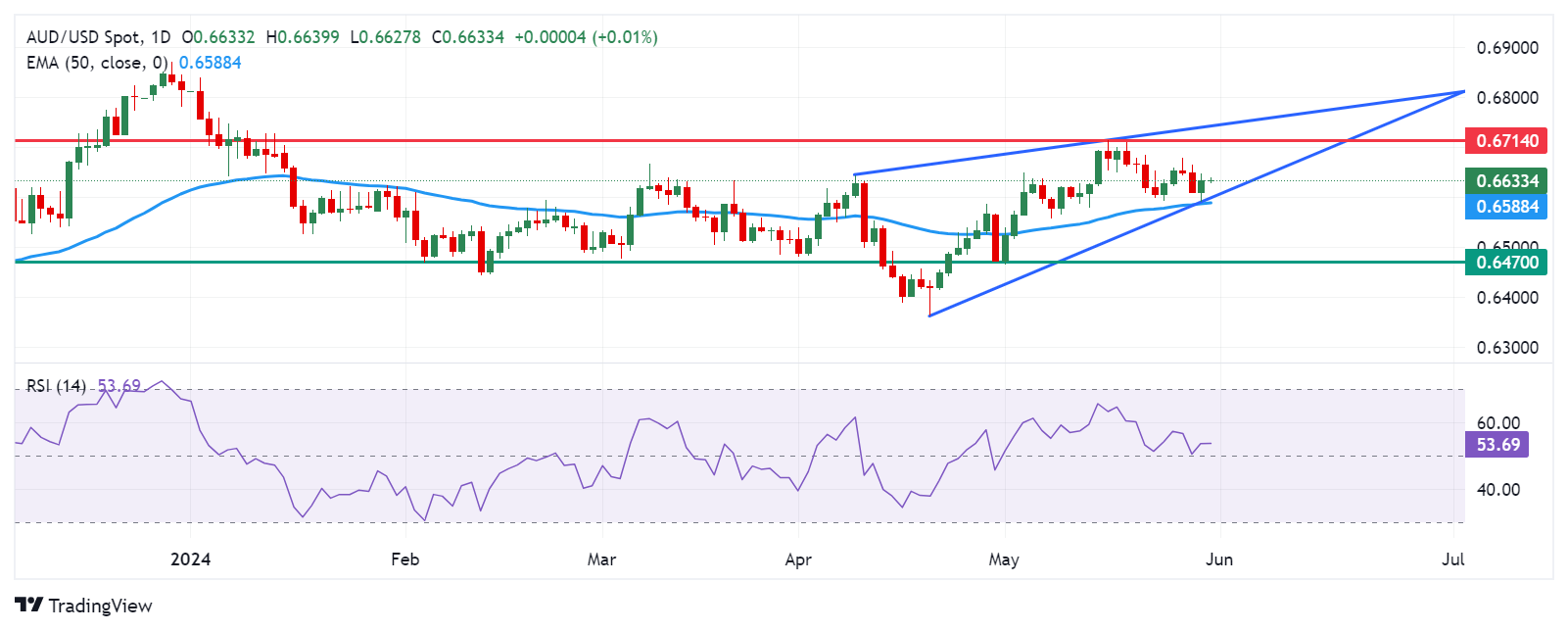- The Australian Dollar held ground despite softer China’s PMI data released on Friday.
- The AUD could appreciate due to the hawkish sentiment surrounding the RBA hiking rates.
- The US Dollar rebounded as Fed's Logan expressed concerns about upside risks to inflation.
The Australian Dollar (AUD) moves sideways after lower-than-expected NBS Purchasing Managers Index (PMI) data was released from China on Friday. Given the close trade relationship between Australia and China, any changes in the Chinese economy can significantly impact the Australian market. However, the AUD/USD pair had gained ground earlier in the day as the US Dollar (USD) struggled due to a slowdown in the US economy.
The AUD also found support as the monthly inflation rate accelerated to 3.6%, raising the possibility that the Reserve Bank of Australia (RBA) might need to hike interest rates again. Investors anticipate that the RBA will maintain high rates for a longer period, with a rate cut not expected until May next year.
The US Dollar Index (DXY), which measures the US Dollar against six major currencies, could receive pressure from a drop in US Treasury yields. This could be attributed to the US Gross Domestic Product (GDP) Annualized growth rate being revised lower to 1.3% from 1.6% for the first quarter. Traders are likely looking ahead to the Federal Reserve's preferred inflation gauge, the Core Personal Consumption Expenditures (PCE) Price Index, which will be released on Friday.
Daily Digest Market Movers: Australian Dollar consolidates after lower China PMI
- China’s NBS Manufacturing Purchasing Managers Index (PMI) fell to 49.5 in May from 50.4 in April, missing the market consensus of an increase to 50.5. Meanwhile, the Non-Manufacturing PMI declined to 51.1 from the previous reading of 51.2, falling short of the estimated 51.5.
- Australia's Private Capital Expenditure increased by 1.0% in Q1, exceeding expectations for a 0.5% rise and surpassing the previous quarter's 0.9% increase.
- On Thursday, Dallas Fed President Lorie Logan expressed continued concerns about upside risks to inflation despite recent easing. Logan warned that the Federal Reserve needs to remain flexible and keep "all options on the table" as it monitors data and determines how to respond, per Reuters.
- As per a Bloomberg report, RBA Assistant Governor Sarah Hunter said at a conference in Sydney on Thursday that “inflationary pressures" are the key issue. “We’re very mindful of that." Hunter also stated that the RBA Board is concerned about inflation remaining above the target range of 1%-3%, suggesting persistent inflationary pressure. Wages growth appears to be near its peak.
- Bloomberg reported on Wednesday that Atlanta Fed President Raphael Bostic stated that the path to 2% inflation is not assured and that the breadth of price gains is still significant.
- Australia’s Monthly Consumer Price Index rose 3.6% year-over-year in April, surpassing the expected reading of 3.4% and the previous reading of 3.5%.
- On Tuesday, Neel Kashkari, President of the Federal Reserve Bank of Minneapolis, suggested that a rate hike might still be possible. Kashkari stated, “I don’t think anybody has taken rate increases off the table,” and expressed uncertainty about the disinflationary process, predicting only two rate cuts, per MSN.
- US Housing Price Index (MoM) for March underperformed, with March's number coming in at 0.1% against 1.2% for February, where 0.5% was expected.
Technical Analysis: Australian Dollar remains above the key level of 0.6600
The Australian Dollar trades around 0.6630 on Friday. An analysis of the daily chart suggests a bullish bias for the AUD/USD pair as it consolidates within the rising wedge. The 14-day Relative Strength Index (RSI) is positioned slightly above the 50 level, confirming a bullish bias.
The AUD/USD pair could target the psychological level of 0.6700, followed by the four-month high of 0.6714 and the upper limit of the rising wedge around 0.6740.
On the downside, the immediate support appears at the psychological level of 0.6600 around the lower boundary of the rising wedge. The next support appears at the 50-day Exponential Moving Average (EMA) at 0.6588. A further decline could exert downward pressure on the AUD/USD pair, potentially driving it toward the throwback support region at 0.6470.
AUD/USD: Daily Chart
Australian Dollar price today
The table below shows the percentage change of the Australian Dollar (AUD) against listed major currencies today. The Australian Dollar was the strongest against the Pound Sterling.
| USD | EUR | GBP | CAD | AUD | JPY | NZD | CHF | |
| USD | 0.09% | 0.17% | -0.08% | -0.09% | 0.03% | -0.13% | 0.14% | |
| EUR | -0.07% | 0.08% | -0.16% | -0.15% | -0.04% | -0.19% | 0.07% | |
| GBP | -0.18% | -0.11% | -0.26% | -0.26% | -0.15% | -0.30% | -0.04% | |
| CAD | 0.08% | 0.12% | 0.25% | -0.01% | 0.12% | -0.04% | 0.23% | |
| AUD | 0.09% | 0.15% | 0.24% | 0.00% | 0.12% | -0.04% | 0.22% | |
| JPY | -0.03% | 0.02% | 0.12% | -0.11% | -0.15% | -0.16% | 0.11% | |
| NZD | 0.09% | 0.18% | 0.28% | 0.02% | 0.05% | 0.13% | 0.26% | |
| CHF | -0.13% | -0.09% | 0.02% | -0.23% | -0.23% | -0.11% | -0.27% |
The heat map shows percentage changes of major currencies against each other. The base currency is picked from the left column, while the quote currency is picked from the top row. For example, if you pick the Euro from the left column and move along the horizontal line to the Japanese Yen, the percentage change displayed in the box will represent EUR (base)/JPY (quote).
Australian Dollar FAQs
One of the most significant factors for the Australian Dollar (AUD) is the level of interest rates set by the Reserve Bank of Australia (RBA). Because Australia is a resource-rich country another key driver is the price of its biggest export, Iron Ore. The health of the Chinese economy, its largest trading partner, is a factor, as well as inflation in Australia, its growth rate and Trade Balance. Market sentiment – whether investors are taking on more risky assets (risk-on) or seeking safe-havens (risk-off) – is also a factor, with risk-on positive for AUD.
The Reserve Bank of Australia (RBA) influences the Australian Dollar (AUD) by setting the level of interest rates that Australian banks can lend to each other. This influences the level of interest rates in the economy as a whole. The main goal of the RBA is to maintain a stable inflation rate of 2-3% by adjusting interest rates up or down. Relatively high interest rates compared to other major central banks support the AUD, and the opposite for relatively low. The RBA can also use quantitative easing and tightening to influence credit conditions, with the former AUD-negative and the latter AUD-positive.
China is Australia’s largest trading partner so the health of the Chinese economy is a major influence on the value of the Australian Dollar (AUD). When the Chinese economy is doing well it purchases more raw materials, goods and services from Australia, lifting demand for the AUD, and pushing up its value. The opposite is the case when the Chinese economy is not growing as fast as expected. Positive or negative surprises in Chinese growth data, therefore, often have a direct impact on the Australian Dollar and its pairs.
Iron Ore is Australia’s largest export, accounting for $118 billion a year according to data from 2021, with China as its primary destination. The price of Iron Ore, therefore, can be a driver of the Australian Dollar. Generally, if the price of Iron Ore rises, AUD also goes up, as aggregate demand for the currency increases. The opposite is the case if the price of Iron Ore falls. Higher Iron Ore prices also tend to result in a greater likelihood of a positive Trade Balance for Australia, which is also positive of the AUD.
The Trade Balance, which is the difference between what a country earns from its exports versus what it pays for its imports, is another factor that can influence the value of the Australian Dollar. If Australia produces highly sought after exports, then its currency will gain in value purely from the surplus demand created from foreign buyers seeking to purchase its exports versus what it spends to purchase imports. Therefore, a positive net Trade Balance strengthens the AUD, with the opposite effect if the Trade Balance is negative.
Information on these pages contains forward-looking statements that involve risks and uncertainties. Markets and instruments profiled on this page are for informational purposes only and should not in any way come across as a recommendation to buy or sell in these assets. You should do your own thorough research before making any investment decisions. FXStreet does not in any way guarantee that this information is free from mistakes, errors, or material misstatements. It also does not guarantee that this information is of a timely nature. Investing in Open Markets involves a great deal of risk, including the loss of all or a portion of your investment, as well as emotional distress. All risks, losses and costs associated with investing, including total loss of principal, are your responsibility. The views and opinions expressed in this article are those of the authors and do not necessarily reflect the official policy or position of FXStreet nor its advertisers. The author will not be held responsible for information that is found at the end of links posted on this page.
If not otherwise explicitly mentioned in the body of the article, at the time of writing, the author has no position in any stock mentioned in this article and no business relationship with any company mentioned. The author has not received compensation for writing this article, other than from FXStreet.
FXStreet and the author do not provide personalized recommendations. The author makes no representations as to the accuracy, completeness, or suitability of this information. FXStreet and the author will not be liable for any errors, omissions or any losses, injuries or damages arising from this information and its display or use. Errors and omissions excepted.
The author and FXStreet are not registered investment advisors and nothing in this article is intended to be investment advice.
Recommended content
Editors’ Picks

EUR/USD accelerates losses to 1.0930 on stronger Dollar
The US Dollar's recovery regains extra impulse sending the US Dollar Index to fresh highs and relegating EUR/USD to navigate the area of daily troughs around 1.0930 in the latter part of Friday's session.

GBP/USD plummets to four-week lows near 1.2850
The US Dollar's rebound keep gathering steam and now sends GBP/USD to the area of multi-week lows in the 1.2850 region amid the broad-based pullback in the risk-associated universe.

Gold trades on the back foot, flirts with $3,000
Gold prices are accelerating their daily decline, steadily approaching the critical $3,000 per troy ounce mark as the Greenback's rebound gains extra momentum and US yields tighten their retracement.

Can Maker break $1,450 hurdle as whales launch buying spree?
Maker holds steadily above $1,250 support as a whale scoops $1.21 million worth of MKR. Addresses with a 100k to 1 million MKR balance now account for 24.27% of Maker’s total supply. Maker battles a bear flag pattern as bulls gather for an epic weekend move.

Strategic implications of “Liberation Day”
Liberation Day in the United States came with extremely protectionist and inward-looking tariff policy aimed at just about all U.S. trading partners. In this report, we outline some of the more strategic implications of Liberation Day and developments we will be paying close attention to going forward.

The Best brokers to trade EUR/USD
SPONSORED Discover the top brokers for trading EUR/USD in 2025. Our list features brokers with competitive spreads, fast execution, and powerful platforms. Whether you're a beginner or an expert, find the right partner to navigate the dynamic Forex market.




